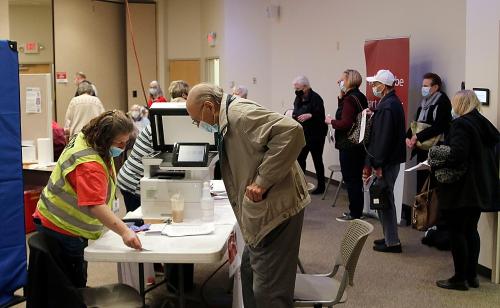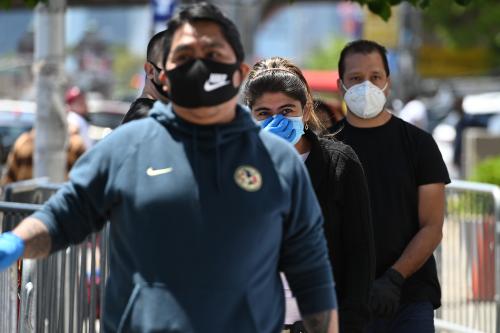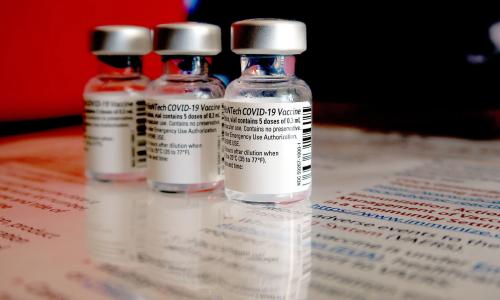As new and more virulent versions of the coronavirus appear around the world and in the United States, the Biden administration is faced with two daunting problems—getting enough vaccines and quickly distributing them to Americans.
In the first few weeks of vaccine administration, most Americans faced systems that seemed impenetrable, random, and haphazard—or serendipitous if, for some reason, you managed to luck out and get a vaccine. The reason is pretty clear. The Trump administration approached this process in the same way it approached the problems of PPE and ventilators early on in the pandemic—by blithely assuming that the states would take care of it without stopping to consider what states may need in the way of help in the face of an unprecedented rise in case numbers.
In contrast, the Biden administration has promised help. In a series of executive orders, President Biden promised to reimburse states for the cost of using their National Guard to help administer vaccines, use FEMA to set up vaccination sites in states, use the Defense Production Act to keep supply lines open.
However, until that help materializes, states have been and will be muddling through, building the airplane as it flies and learning from each other. Some states are doing better than others. Each state receives vaccines based on population—so the number of vaccines available should not be an issue. But states are having different levels of success when it comes to actually getting vaccines to Americans.
At of the end of January, the top five states with the highest percentage of vaccines administered by population were, in order, North Dakota (90.62%), West Virginia (85.12%), New Mexico (83.09%), South Dakota (81.07%), and South Carolina (78.47%). These are all very small states apart from South Carolina, which is a medium-sized state. [i] Looking at the bottom five states in vaccines administered shows a more complicated picture. Three of the states in that group—Rhode Island (52.64%), Idaho (54.56%) and Kansas (53.58%)—are also very small, but Missouri (53.19%) and Alabama (53.68%) are both fairly large, so size does not seem to be the answer. And looking at the size of other countries that are vaccinating people doesn’t give a clear picture either. [ii]
A second explanation for why some states are slower than others at administering vaccines is that some are holding back more second doses than others. Nationally, as of Feb. 1, the CDC was reporting that there were almost 50 million national doses distributed and roughly 31 million doses actually administered.
Many of the 20 million missing doses are being held for second doses. And yet, as the pandemic worsens and new strains of the virus appear, some experts are suggesting that all doses should be used even if that means delaying the second dose for some people until supply catches up. Recently two infectious disease doctors, Adam Finn and Richard Malley, argued in the New York Times, “We must go ahead right now, even without trials, with a one-dose-approach targeting the most vulnerable.”
Finn and Malley were joined by Michael T. Osterholm, director of the Center for Infectious Disease Research and Policy at the University of Minnesota, who believes it’s time to “call an audible” on vaccine distribution. Talking to the Washington Post, Osterholm said, “We still want to get two doses in everyone, but in advance of a surge, we need to get as many one doses in as many people over 65 as we possibly can to reduce the serious illness and deaths that are going to occur over the weeks ahead.”
Some states are going ahead on their own and implementing a partial one dose strategy. In Oklahoma, the executive director of the Tulsa Health Department, Dr. Bruce Dart decided, “We are now pivoting to release half of the second dose inventory on hand as prime doses to add additional appointments. This will allow additional providers in Tulsa County to receive and administer vaccine as well.”
Another source of the slow pace of vaccinations seems to stem from the priority in which vaccines were to be given. While almost everyone agrees that health care workers should be vaccinated before everyone else, officials in some states were surprised that a sizeable proportion of health care workers refused the vaccine. A Kaiser Family Foundation poll found that 29% of health care workers were hesitant to get a Covid-19 vaccine.
Many of those workers are members of minority communities. Black Americans, in particular, have a long history of distrust of medical research due to government-sponsored medical experimentations such as the infamous Tuskegee experiments that began in the 1930s. Latinos, who also are heavily represented in health care, remember the mass sterilization of Puerto Rican women and Mexican men and women.
A second priority group has been nursing homes where an already frail population has died in large numbers from the coronavirus. The federal government contracted with CVS and Walmart to administer vaccines in nursing homes. But that process has not been as quick as some anticipated—especially given that the population is all in one place. Among the critics is Illinois Gov. J.B. Pritzker who blamed a Trump administration program that designated pharmacies to distribute vaccines to long-term care facilities for “bringing our numbers way down” because of how slow it has been to get shots administered.
Part of the slow start may be that the process of getting the necessary paperwork from an elderly population can be challenging since it is difficult to get the proper legal authorizations from people suffering from dementia and Alzheimer’s and other cognitive problems. In addition, the government allocated vaccines to states on the basis of how many beds they had in nursing homes not on the basis of how many patients were in the beds. So, for instance, in Oklahoma, many nursing home beds are empty, and staffing levels are low. Hence, they, and perhaps others, have the ability to take the doses allotted to nursing homes and start distributing them to the broader population. West Virginia, the state that, to everyone’s surprise, has been at the top in terms of vaccination efficacy, is the only state to have opted out of the federal pharmacy program; choosing instead to use a network of over 200 local pharmacies for vaccine distribution. This seems to have avoided the bureaucratic snafus that some states are attributing to the federal program and it has increased trust in the population since the providers are known in the community. “On Dec. 30, West Virginia became the first state to complete round one of the two-shot series in nursing homes by partnering with local pharmacies.”
Another aspect of vaccine administration may be simply the sheer number of sites a state sets up for giving vaccines. In mid-January, Massachusetts, with 6.9 million people, had only 65 locations. In contrast, Burleigh County, North Dakota, the second most populated county in a very sparsely populated state, had at that time, 54 locations for its almost 100,000 residents. As of Jan. 29, West Virginia listed 250 vaccination sites, while the much bigger state of Pennsylvania listed only 274. In Alaska, public health workers have been flying planes into remote villages and dropping off vaccines to locals. Having local vaccination sites is especially important in poor communities where people do not have cars and must rely on public transportation to get around. For the elderly, an appointment 4.5 hours away may simply not be feasible unless they can convince someone to drive them. And for minorities wary of vaccines in the first place, traveling to an all-white county, hours away from home, is not likely to increase their chances of taking it.
Unless precautions are taken, vaccine administration is likely to enhance the already large health disparities between different racial groups. The District of Columbia has addressed some of these issues by prioritizing vaccine signups by the rate of Covid-19 infections in particular zip codes. Thus, the hardest-hit zip codes, which also tend to have a greater proportion of people of color and front-line workers, are offered vaccines before the wealthier, whiter zip codes where Covid-19 cases are lower.
Holding back doses for second doses, reluctant health care workers, and nursing home residents seems to have slowed the administration of the first round of vaccines. Nonetheless, in the past month, the pace of vaccinations has increased. As of Jan. 31, the U.S. was administering about 1.3 million vaccines a day. Once the federal government’s assistance kicks in and the states build their systems and then debug them, the country should be able to administer 1.7 million vaccines per day.
Which is where supply comes in.
Last week, the Biden administration told governors that because of increased manufacturing, they will get 16% more vaccine doses for the next three weeks. But there are real concerns about how quickly the vaccines can be manufactured after that. And the problems are just beginning. Along with supply shortages comes even more explosive equity issues. For instance, should a 40-year-old Latino grocery store clerk be vaccinated sooner than a retired white 70-year-old? Coupled with possible shortages in supply the next few months will be even more difficult than the first ones.
| Top 5 States in Vaccines Administered | % of vaccines administered | Rank in terms of U.S. Pop. |
| West Virginia | 85.12% | 40 |
| North Dakota | 90.62% | 48 |
| South Dakota | 81.07% | 47 |
| New Mexico | 83.09% | 37 |
| South Carolina | 78.47% | 23 |
Sources: CDC (As of February 1, 2021), World Population Review.
[ii] The international picture is also muddled. The top five countries in the world that have done the best job so far getting vaccines into people’s arms are Israel, United Arab Emirates, and Bahrain—three very small countries. The United Kingdom, a mid-sized country ranks third and the United States ranks fifth.
The Brookings Institution is committed to quality, independence, and impact.
We are supported by a diverse array of funders. In line with our values and policies, each Brookings publication represents the sole views of its author(s).








Commentary
What’s the hold up? Why more vaccines haven’t been administered
February 2, 2021